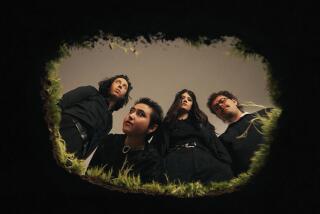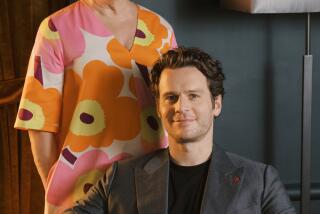LITTLE SUSIE WAKES UP IN EVERLYVILLE
- Share via
SHENANDOAH, Iowa — A lot of people spit in Thomas Wolfe’s eye a couple of weekends ago when they returned to my hometown. The Everly Brothers, Shenandoah’s most famous ex-citizens, were going to give a homecoming concert and the pull was irresistible.
Feeling guilty about calling them hillbilly singers when they performed on Shenandoah’s KMA radio in the ‘40s and early ‘50s, and having trailed a few years behind the brothers in school, I didn’t plan to attend. But the lure of the spectacle and the promise of seeing old friends got the best of me.
Phil and Don would not only do a homecoming concert, they would donate a big hunk of the proceeds to a Shenandoah High School scholarship fund, visit old haunts and kiss their ex-girlfriends. This was enough to make the cornfields steam, and the Shenandoah Evening Sentinel made the most of the news. As columnist Jeri Naven wrote, “One has to soak this for all it’s worth because once it’s over, we’ll all go back to sitting on our front porches, smashing ants with a claw hammer.”
On the day of the concert Sheridan Avenue was lined with people waiting to see The Boys ride through town in a parade. Some merchants had been skeptical of the whole affair, fearing an influx of riffraff, but a stern editorial in the Sentinel set them straight. By the time the Everlys sallied forth to do the town, the stores were decked with Welcome Home signs. The most creative shop keepers had raided their closets to re-create the era when the Everlys left Shenandoah for Nashville and released their first hits, “Wake Up Little Susie” and “Bye Bye Love.” Mae Farmer’s Apparel staged the classiest display with mannequins wearing poodle skirts, letter sweaters and bobby socks.
“The Everly Brothers Homecoming Parade” was straight from the ‘50s too, with floats bearing past SHS homecoming queens and alums dressed 30 years behind the times. Julie Sullivan Briggs blossomed out in the very gown she had worn when she was crowned in 1961.
Shenandoah’s retired band director, Robert Creighton, had put out a call for anyone who had ever played in the Shenandoah Marching Band to show up for practice. A handsome Music Man so charismatic that he makes Meredith Willson look like a wimp, Creighton enlisted 80 or so ex-musicians who marched in the parade, playing “The Stars and Stripes Forever” and the Shenandoah High School fight song. They were accompanied by a bevy of baton twirlers and flag wavers--all rumored to be over 40, though I’ve been assured that one is only 38.
The Boys were bowled over by all the fuss. They received a key to the city, and the Sentinel published a special Everly Brothers Homecoming Edition. Freemont Street, a highway leading into town, was renamed Everly Brothers Avenue. A stone monument engraved in the Everlys’ honor was dedicated alongside a monument marking the spot where President Theodore Roosevelt spoke in 1903.
The concert itself--an open-air affair--was a raging success. Sitting on folding chairs and hay bales, the family-style crowd thrilled to the nostalgic program as the singers went all out to please the homefolks. The whole shebang was orchestrated by Bill Hillman, a 32-year-old local entrepreneur who had finally achieved his life’s goal of enticing the Everlys back to Shenandoah.
Through it all, Phil and Don were so gracious that most people privately decided they were either very good actors or very glad to be in town. Hillman insists the latter is true. As the pair said in various interviews, Shenandoah was the only real home they ever had. Returning to Iowa gave them a chance to relive their youth as special entertainers and regular kids.
Amid the hoopla, another famous person came home to Shenandoah--for the last time. Tom Offenburger, a former neighbor of mine, had died during heart surgery in Atlanta. A white journalist who had resigned as Chicago bureau chief of U.S. News and World Report in 1966 to become a civil rights activist, he was press secretary to Martin Luther King Jr., Ralph Abernathy and, for more than a decade, to Andrew Young during the Georgia politician’s service as U.S. congressman, ambassador to the United Nations and mayor of Atlanta.
Young made his first trip to Shenandoah to deliver a eulogy for the highly revered man he said had “interpreted the Civil Rights Movement,” turning “a hostile press into seekers of the truth.”
Shenandoans weren’t accustomed to mayoral entourages, but they were used to Tom. His father had died young, leaving Tom’s mother, Anna, with seven children--all of whom turned out to be solid gold. No one but Anna knows how she raised those kids. She says God gave them to her so she wouldn’t have time to feel sorry for herself.
As we crossed arms at the funeral and sang “We Shall Overcome,” the song seemed to apply as strongly to the family as to the civil rights struggle. The Offenburgers don’t take much time out for mourning.
Tom’s brother, Chuck, a columnist for the Des Moines Register who was covering the Everlys’ homecoming, had worried in print that some people might consider him a jerk for whooping it up with the Everlys so soon after his brother had died. But he saw it as a celebration of life, so he stepped up on the concert stage and got the audience to give Hillman a hand for making Shenandoah feel good about itself.
Full of thoughts on the meaning of life, death, roots and adolescent memories, I flew off to Los Angeles. Somewhere over Nebraska, I realized that Jeri Naven had lied; Shenandoans don’t have time to sit on their porches smashing ants with claw hammers.
More to Read
Sign up for Essential California
The most important California stories and recommendations in your inbox every morning.
You may occasionally receive promotional content from the Los Angeles Times.













